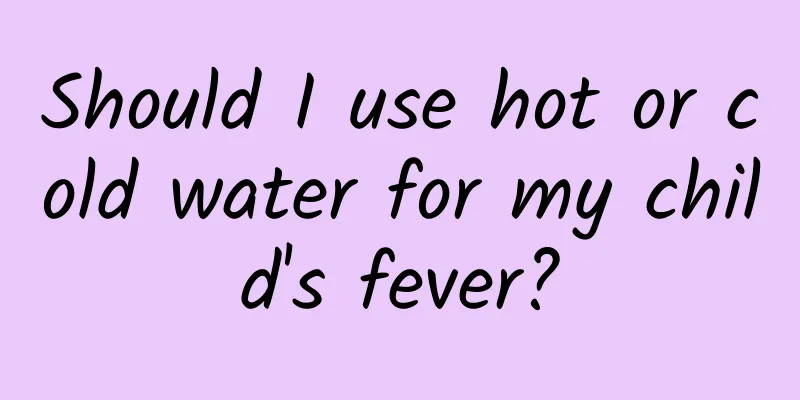Should I use hot or cold water for my child's fever?

|
Because children have weak resistance, once they catch a cold, they will have a fever. Generally speaking, high fever needs to be treated in the hospital in time, but in some special periods, if it is inconvenient, then it is necessary to help the child reduce the fever in time. Generally speaking, physical methods are the best way to reduce fever in children. So, do parents know whether to use hot water or cold water to apply when children have a fever? The difference between warm water compress and cold water compress It is recommended to use warm water. The treatment methods for adults and children are basically the same, but children are more likely to have fever. Analysis: Hot water that is too hot will irritate the child's skin and nerves. On the one hand, it is easy to add heat to the heat, and on the other hand, the child may be unwilling to cooperate due to the stimulation. Cold water will shrink the child's pores, making it difficult to expel the heat from the body, which is counterproductive. Warm water is closest to the child's body temperature, and it is not easy to cause excessive stimulation, so the child is willing to accept it. At the same time, rubbing the body with warm water can open the skin pores and expel heat, which can truly achieve the effect of physical cooling. Fever is an increase in body temperature. An armpit temperature between 37.5℃ and 38℃ is a low fever, 39℃ to 40℃ is a high fever, and over 40℃ is called hyperthermia. In case of high fever, various physical cooling methods should be used correctly and reasonably, such as low-temperature water baths, warm and wet compresses, ice compresses, cold compresses on the head or ice packs on the head, alcohol rub baths, etc. What to do if your baby has a fever Because the baby's basal body temperature is between 36.9℃ and 37.5℃, and if the baby's temperature continues to rise and exceeds 37.5℃, then parents should start to cool the baby down. You can help your child cool down by: 1. Change the environment. Place the baby in a cool place with good air circulation, and reduce the amount of clothes and blankets appropriately. Be careful not to hold the baby tightly in the arms of an adult, as this will prevent the body heat from being difficult to dissipate. Placing the baby in an open room in summer can help reduce the baby's temperature. 2. Apply with a wet towel. Wipe your baby's limbs with a warm towel, or apply a wet towel to the forehead to help reduce fever. 3. Take a warm water bath. For a tub bath, the water temperature should be 2-3℃ lower than the baby's body temperature. You can also add a few drops of wind oil to warm water and let the baby soak in the water for 10-15 minutes. If the baby cannot be bathed due to limited conditions, you can use a warm wet towel to repeatedly wipe the baby's whole body for 10-15 minutes. 4. Feed your baby water repeatedly and let him rest in bed as much as possible. While taking the above-mentioned fever-reducing measures for babies with fever, you should closely observe the baby's other conditions, such as whether he has a cough, his mental state, etc. If the temperature is too high, go to the hospital for treatment. How to reduce fever physically For families, the most effective physical cooling method for common diseases such as fever is to drink water. In addition to drinking water, we should also first prepare practical rules for fever. For example, it is not suitable to drink cold water. Warm boiled water of a certain temperature is most suitable. If the fever is caused by a cold, making a cup of cold medicine may be of some help. In addition to drinking water, we should also use the following physical methods to cool down: 1. Wear less clothes to dissipate heat. The traditional idea is that when you have a fever, you should wrap yourself tightly with clothes and quilts to "force" out the sweat, but this is actually wrong. When they have a fever, they may shiver and sometimes think they have chills, but this is actually due to cramps caused by their increased body temperature. 2. Cold wet compress on the head: Soak a soft towel in 20℃ ~ 30℃ cold water, squeeze it slightly to prevent dripping, fold it and place it on the forehead, change it every 3 to 5 minutes. 3. Head ice pillow: Fill the ice bag half full with small ice cubes and a small amount of water, expel the air from the bag, press the bag opening tightly, and place it on the pillow after there is no water leakage. 4. Wipe with warm water or take a warm bath: Wipe the child's head, armpits, limbs with a warm and wet towel or take a warm bath, scrub the skin more to promote heat dissipation. 5. Alcohol bath is also a good method: suitable for cooling down high fever. Prepare 200-300 ml of 20%-35% alcohol and use it to rub the limbs and back. Precautions for fever Fever is one of the physiological reactions when the body is infected or inflamed. Therefore, the most fundamental and important thing after a fever occurs is for a doctor to find out the cause and treat it symptomatically. Of course, in addition to treating the underlying disease, symptomatic treatment of fever can be helpful when there is a fever, especially a high fever, or when the fever causes discomfort. However, for a smooth recovery, please pay attention to and cooperate with the following matters: 1. Rest in bed: Please rest in bed when you have a fever to help you recover your strength and get well soon. 2. Replenish water: When you have a fever, the loss of water in the body will accelerate, so it is advisable to drink more boiled water, juice, sports drinks or beverages without alcohol or caffeine as far as possible. 3. Try to avoid wearing too many clothes or covering yourself with thick quilts, as this will make it difficult for the body to dissipate heat and aggravate the discomfort and severity of the fever. 4. Take medication regularly: Please be sure to follow the doctor's instructions and take medication at regular times and in regular amounts. If you still feel uncomfortable when the medication is finished, please go to a medical institution for treatment and continue treatment. 5. If the fever temperature exceeds 39°C, you need to take antipyretic drugs. 6. If the fever temperature exceeds 39°C, please wipe the body with warm water. When the water evaporates from the body surface, it will take away extra heat, improve the fever and relieve discomfort. If a persistent fever of more than 39°C occurs and does not respond well to drug treatment. If you have severe headache or head stiffness, you should seek medical attention immediately. |
<<: What did water beans look like originally?
>>: How to prevent children's teeth from growing crooked
Recommend
How to whiten boys' skin, there are secret recipes for men's whitening
Everyone loves beauty. Whitening is not just a fe...
What tea can I drink to treat acne?
From the surface, acne is caused by blockage of s...
What are the symptoms of Qi deficiency in pregnant women? It can be analyzed from two aspects
Pregnant women are prone to symptoms of qi and bl...
Purulent tonsillitis
Tonsillitis is a very common disease in our lives...
What are the characteristics and symptoms of ankylosing spondylitis in women?
In clinical work, there are quite a few female an...
What to do if you are allergic to cold air
Because of the cold air, the indoor temperature i...
What does amylase do in the body?
Clinically, amylase mainly plays a certain role i...
What causes acute encephalitis?
Acute encephalitis, also known as acute meningiti...
What is the best way to relieve Achilles tendon pain?
The health of the feet has a great impact on our ...
What to drink to prevent colds
Colds are the most common and common disease symp...
Bleeding at 42 days of pregnancy
Bleeding during pregnancy is not a normal phenome...
Baby retches when sucking breast milk
The first mouthful of milk a baby eats after birt...
Chickenpox Chinese medicine prescription
Severe chickenpox patients will also experience s...
What are the medicinal values of Chuanpo Stone?
We in China have many magical medicinal herbs tha...
Whole gastrointestinal tract radiography
Whole gastrointestinal tract radiography refers t...









